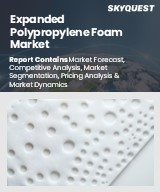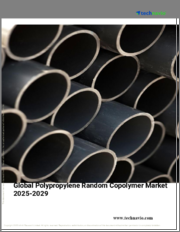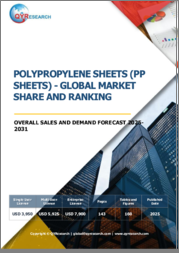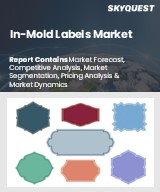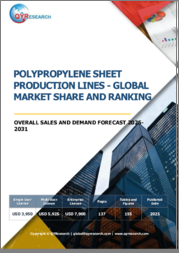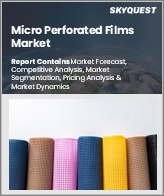
|
시장보고서
상품코드
1646792
세계의 바이오 기반 폴리프로필렌(PP) 시장Bio-based Polypropylene (PP) |
||||||
바이오 기반 폴리프로필렌(PP) 세계 시장은 2030년까지 4억 4,330만 달러에 달할 전망
2024년에 1억 6,020만 달러로 추정되는 바이오 기반 폴리프로필렌(PP) 세계 시장은 2030년에는 4억 4,330만 달러에 달할 것으로 예상되며, 분석 기간인 2024-2030년 동안 연평균 18.5%로 성장할 것으로 예상됩니다. 본 보고서에서 분석한 부문 중 하나인 사출 성형 응용 분야는 CAGR 17.5%를 기록하여 분석 기간 종료 시점에 2억 2,520만 달러에 도달할 것으로 예상됩니다. 섬유 응용 부문의 성장률은 분석 기간 동안 CAGR 20.4%로 추정됩니다.
미국 시장 4,270만 달러로 추정, 중국은 CAGR 17.4%로 성장 전망
미국의 바이오 기반 폴리프로필렌(PP) 시장은 2024년 4,270만 달러 규모에 달할 것으로 예상됩니다. 세계 2위의 경제 대국인 중국은 분석 기간인 2024년부터 2030년까지 연평균 17.4%의 성장률을 보이며 2030년에는 6,750만 달러의 시장 규모를 형성할 것으로 예상됩니다. 다른 주목할 만한 지역 시장으로는 일본과 캐나다가 있으며, 분석 기간 동안 각각 16.8%와 16.0%의 CAGR을 기록할 것으로 예상됩니다. 유럽에서는 독일이 CAGR 약 13.7%로 성장할 것으로 예상됩니다.
세계 바이오 기반 폴리프로필렌(PP) 시장 - 주요 동향 및 촉진요인 요약
바이오 기반 폴리프로필렌이란?
바이오 기반 폴리프로필렌(PP)은 재료 과학의 혁신적인 전환을 상징하는 것으로, 석유에서 추출한 열가소성 폴리머로 널리 사용되는 기존 폴리프로필렌을 대체할 수 있는 재생 가능한 대안을 제시합니다. 화석연료를 원료로 하는 것과 달리, 바이오 기반 PP는 옥수수, 사탕수수 등 재생 가능한 바이오매스 원료를 사용하여 제조되기 때문에 환경 부하를 줄이고자 하는 산업계에 친환경적인 대안이 될 수 있습니다. 바이오 기반 PP의 중요성은 내구성, 내화학성, 범용성 등 기존 폴리프로필렌의 귀중한 특성을 유지하면서 온실가스 배출, 유한한 화석 자원에 대한 과도한 의존 등 당면한 환경 문제를 해결할 수 있다는 점에 있습니다. 폴리프로필렌은 자동차, 포장, 섬유, 소비재 등 다양한 분야에서 사용되고 있으며, 기존 생산 라인에 원활하게 통합될 수 있는 지속가능한 대체 소재에 대한 필요성이 높아지고 있습니다. 소비자, 정부 및 규제 기관의 지속가능한 관행에 대한 압력이 증가함에 따라, 바이오 기반 PP는 보다 친환경적이고 순환적인 생산 모델에 대한 수요 증가에 따라 실행 가능한 솔루션으로 부상하고 있습니다. 바이오 기반 PP는 석유에 대한 의존도를 줄이고 순환 경제를 지원함으로써 제조업체와 소비자가 폴리프로필렌 제품에서 기대하는 품질과 성능을 보장하면서 탄소 배출량을 줄이고 야심찬 지속가능성 목표를 달성할 수 있는 경로를 업계에 제공합니다.
바이오 기반 폴리프로필렌은 어떻게 생산되며, 어떤 장점이 있는가?
바이오 기반 폴리프로필렌의 제조는 옥수수, 사탕수수, 농산물 등 재생 가능한 바이오매스 자원에서 당을 추출하는 것으로 시작됩니다. 이 당은 발효 과정을 거쳐 폴리프로필렌의 기본 구성요소인 바이오 기반 프로필렌으로 전환됩니다. 프로필렌이 생성되면 중합을 통해 기존 화석 유래 폴리프로필렌과 화학적으로 동일한 폴리프로필렌이 형성됩니다. 이러한 화학적 동등성으로 인해 바이오 기반 PP는 기존 PP와 동일한 기계적 강도, 내화학성 및 유연성을 구현하여 제조업체가 장비 및 제조 공정을 변경하지 않고도 사용할 수 있는 "드롭 인" 대체품이 됩니다. 이러한 호환성은 재료 특성의 변화가 품질 및 안전 기준을 방해할 수 있는 자동차 및 소비자 포장과 같이 생산 기준이 까다로운 산업에서 특히 유용합니다. 바이오 기반 PP는 기능적 이점뿐만 아니라 환경적 측면에서도 큰 이점을 제공합니다. 바이오 기반 PP는 성장 과정에서 CO2를 흡수하는 식물에서 유래하기 때문에 화석 기반 PP에 비해 탄소발자국이 현저히 낮으며, 수명 주기 동안 온실 가스 배출량을 줄이는 데 기여합니다. 또한, 바이오 기반 PP는 기존 재활용 시스템과 원활하게 통합될 수 있어 기존 PP와 함께 재사용 및 재활용이 가능하여 지속가능한 폐기물 관리의 광범위한 목표를 지원합니다. 바이오 기반 PP는 생태계에 대한 책임을 다하면서도 성능을 유지할 수 있기 때문에 제품 품질이나 업무 효율성을 희생하지 않고 친환경 소재로 혁신을 이루고자 하는 기업에게 매력적인 선택이 될 수 있습니다.
바이오 기반 폴리프로필렌은 시장에서 어떤 도전에 직면하고 있는가?
바이오 기반 폴리프로필렌은 큰 잠재력을 가지고 있지만, 시장 규모를 확대하고 널리 수용되기까지 상당한 도전에 직면해 있습니다. 바이오 기반 PP의 생산에는 일반적으로 기존 폴리프로필렌보다 높은 비용이 들기 때문에 비용이 여전히 큰 걸림돌로 작용하고 있습니다. 이러한 가격 차이는 특히 기업이 수익률이 낮은 패키징과 같이 비용에 민감한 산업에서 바이오 기반 PP의 경쟁력을 떨어뜨릴 수 있습니다. 바이오 기반 PP의 생산은 계절적 변동과 날씨, 바이오연료 및 바이오화학 등 다른 바이오 기반 분야의 경쟁 수요에 영향을 받는 농업 투입물에 의존하고 있기 때문입니다. 이러한 농업 자원에 대한 의존도는 식량 생산과의 경쟁 가능성에 대한 우려를 불러일으킵니다. 일부 비평가들은 플라스틱 생산에 토지와 농작물을 투입하는 것이 식량 수급과 가격 결정에 부정적인 영향을 미칠 수 있다고 주장합니다. 또한, 바이오 기반 플라스틱과 생분해성 플라스틱은 종종 혼동되기 때문에 소비자의 인식이 채택의 장벽이 될 수 있습니다. 바이오 기반 PP는 화학적으로 기존 PP와 동일하고 생분해되지 않기 때문에 환경 친화적인 소비자들은 그 생태학적 이점에 의문을 가질 수 있습니다. 생분해성과는 달리 바이오 기반 소재와 탄소 저감에 미치는 영향의 차이에 대해 소비자를 교육하는 것은 이러한 인식의 장애물을 극복하는 데 필수적입니다. 이러한 도전은 바이오 기반 PP의 시장 입지를 강화하기 위해 생산 비용을 낮추고, 지속가능한 원료를 확보하며, 바이오 기반 PP의 환경적 이점을 명확히 하기 위한 지속적인 기술 혁신의 필요성을 강조합니다.
바이오 기반 폴리프로필렌 시장의 성장 원동력은?
바이오 기반 폴리프로필렌 시장의 성장을 촉진하는 것은 환경 인식, 규제 압력, 그리고 바이오 기반 생산을 보다 실현 가능하고 비용 효율적으로 만드는 기술 발전의 결합입니다. 전 세계 정부가 탄소 배출량을 줄이고 화석 연료에 대한 의존도를 최소화하기 위한 야심찬 목표를 설정함에 따라, 산업계는 이러한 지속가능성 목표에 부합하는 재료와 공정을 채택할 것을 점점 더 강력하게 요구받고 있습니다. 바이오 기반 PP는 기업의 사회적 책임(CSR) 목표를 달성하고자 하는 기업들에게 전체 온실가스 배출량을 줄이고 석유화학 원료 대신 재생 가능한 자원을 사용하는 매력적인 솔루션을 제공합니다. 자동차 산업과 포장 산업은 배출가스 및 폐기물 관리에 대한 규제가 강화됨에 따라 바이오 기반 재료의 통합에 특히 집중하고 있습니다. 바이오 정제 및 바이오매스 전환의 기술 발전은 바이오 기반 PP의 기존 폴리프로필렌에 대한 비용 경쟁력을 높여 시장 진입을 확대할 수 있게 해줍니다. 소비자의 선호도가 지속가능한 특성을 가진 제품으로 이동함에 따라 PP와 같은 바이오 기반 소재에 대한 수요는 소비재에서 섬유에 이르기까지 다양한 분야에서 증가하고 있습니다. 또한, 바이오 정제 공장, 수지 제조업체, 최종사용자 산업 간의 협력으로 기술 혁신이 가속화되고 바이오 기반 PP 제품의 가용성이 확대되고 있습니다. 이러한 파트너십은 비용 절감, 생산 효율성 향상, 수요 확대에 필요한 기술 확장에 필수적입니다. 좋은 규제 동향과 기술 발전과 함께 바이오 기반 PP는 지속가능한 제조업으로의 전환에 있어 매우 중요한 재료로 자리매김하고 있으며, 재생 가능한 자원이 세계 생산 및 재료 혁신에 있어 핵심적인 역할을 하는 미래를 뒷받침하고 있습니다.
부문
용도(사출, 섬유, 필름, 기타 용도)
조사 대상 기업 사례(주목 43개사)
- Biobent Polymers
- Braskem S.A.
- Dow, Inc.
- DuPont de Nemours, Inc.
- FKuR Kunststoff GmbH
- Global Bioenergies SA
- Neste
- Novamont SpA
- PTT Global
- SABIC
- Sinopec Group
목차
제1장 조사 방법
제2장 주요 요약
- 시장 개요
- 주요 기업
- 시장 동향과 성장 촉진요인
- 세계 시장 전망
제3장 시장 분석
- 미국
- 캐나다
- 일본
- 중국
- 유럽
- 프랑스
- 독일
- 이탈리아
- 영국
- 기타 유럽
- 아시아태평양
- 기타 지역
제4장 경쟁
ksm 25.02.14Global Bio-Based Polypropylene (PP) Market to Reach US$443.3 Million by 2030
The global market for Bio-Based Polypropylene (PP) estimated at US$160.2 Million in the year 2024, is expected to reach US$443.3 Million by 2030, growing at a CAGR of 18.5% over the analysis period 2024-2030. Injection Molding Application, one of the segments analyzed in the report, is expected to record a 17.5% CAGR and reach US$225.2 Million by the end of the analysis period. Growth in the Textiles Applications segment is estimated at 20.4% CAGR over the analysis period.
The U.S. Market is Estimated at US$42.7 Million While China is Forecast to Grow at 17.4% CAGR
The Bio-Based Polypropylene (PP) market in the U.S. is estimated at US$42.7 Million in the year 2024. China, the world's second largest economy, is forecast to reach a projected market size of US$67.5 Million by the year 2030 trailing a CAGR of 17.4% over the analysis period 2024-2030. Among the other noteworthy geographic markets are Japan and Canada, each forecast to grow at a CAGR of 16.8% and 16.0% respectively over the analysis period. Within Europe, Germany is forecast to grow at approximately 13.7% CAGR.
Global Bio-based Polypropylene (PP) Market - Key Trends and Drivers Summarized
What Is Bio-based Polypropylene, and Why Is It Important?
Bio-based polypropylene (PP) represents an innovative shift in materials science, offering a renewable alternative to traditional polypropylene, a widely used thermoplastic polymer commonly derived from petroleum. Unlike its fossil-fuel-based counterpart, bio-based PP is produced using renewable feedstocks like corn, sugarcane, or other forms of biomass, making it an eco-friendly choice for industries seeking to reduce environmental impact. The importance of bio-based PP lies in its ability to retain the valuable properties of traditional polypropylene—such as durability, chemical resistance, and versatility—while also addressing pressing environmental concerns, such as greenhouse gas emissions and the over-reliance on finite fossil resources. Polypropylene’s widespread application in sectors ranging from automotive and packaging to textiles and consumer goods underscores the need for a sustainable alternative that can seamlessly integrate into existing production lines. With rising pressure from consumers, governments, and regulatory bodies to adopt sustainable practices, bio-based PP emerges as a viable solution that aligns with the growing demand for greener, more circular production models. By reducing the dependence on petroleum and supporting a circular economy, bio-based PP offers industries a pathway toward achieving ambitious sustainability goals, helping to lower carbon footprints while ensuring the same quality and performance that manufacturers and consumers expect from polypropylene products.
How Is Bio-based Polypropylene Produced, and What Are Its Benefits?
Bio-based polypropylene production begins by extracting sugars from renewable biomass sources such as corn, sugarcane, or agricultural byproducts. These sugars undergo a fermentation process where they are converted into bio-based propylene, the foundational building block of polypropylene. Once the propylene is generated, it undergoes polymerization to form polypropylene that is chemically identical to conventional, fossil-derived polypropylene. This chemical equivalence allows bio-based PP to deliver the same mechanical strength, chemical resistance, and flexibility as traditional PP, making it a “drop-in” replacement that manufacturers can use without altering their equipment or production processes. This compatibility is particularly beneficial for industries with high production standards, such as automotive and consumer packaging, where any changes in material properties could disrupt quality or safety standards. Beyond its functional benefits, bio-based PP offers substantial environmental advantages. Since it is derived from plant sources that absorb CO2 during growth, bio-based PP has a considerably lower carbon footprint compared to fossil-based PP, contributing to reduced greenhouse gas emissions over its lifecycle. Additionally, bio-based PP integrates seamlessly with current recycling systems, meaning it can be reused or recycled along with conventional PP, supporting broader goals in sustainable waste management. The ability of bio-based PP to maintain performance while promoting ecological responsibility makes it an appealing choice for companies looking to innovate with eco-friendly materials without sacrificing product quality or operational efficiency.
What Challenges Does Bio-based Polypropylene Face in the Market?
While bio-based polypropylene holds considerable promise, it faces notable challenges that impact its ability to scale and achieve widespread market acceptance. Cost remains a significant hurdle, as bio-based PP production generally involves higher expenses than traditional polypropylene, primarily due to the costs associated with sourcing and processing renewable feedstocks. This price disparity can make bio-based PP less competitive, particularly in cost-sensitive industries like packaging, where companies operate on tight profit margins. Another challenge lies in feedstock availability, as bio-based PP production depends on agricultural inputs that are subject to seasonal fluctuations, weather conditions, and competing demands from other bio-based sectors, such as biofuels and bio-chemicals. This dependency on agricultural resources raises concerns around the potential competition with food production, as some critics argue that dedicating land and crops to plastic production could negatively impact food availability and pricing. Additionally, consumer perception can pose a barrier to adoption, as there is often confusion between bio-based and biodegradable plastics. Bio-based PP is chemically identical to conventional PP, meaning it is not biodegradable, which may lead environmentally conscious consumers to question its ecological benefits. Educating consumers on the distinctions between bio-based materials and their impact on carbon reduction, as opposed to biodegradability, will be essential for overcoming this perception hurdle. These challenges underscore the need for ongoing innovation to lower production costs, secure sustainable feedstocks, and clarify the environmental advantages of bio-based PP in order to strengthen its position in the market.
What Drives the Growth of the Bio-based Polypropylene Market?
The growth of the bio-based polypropylene market is fueled by a confluence of environmental awareness, regulatory pressures, and technological advancements that are making bio-based production more feasible and cost-effective. With governments worldwide setting ambitious targets to reduce carbon emissions and minimize dependency on fossil fuels, industries are under increasing pressure to adopt materials and processes that align with these sustainability goals. Bio-based PP presents an attractive solution for companies seeking to meet corporate social responsibility (CSR) targets, as it offers a reduction in overall greenhouse gas emissions and uses renewable resources instead of petrochemical-derived inputs. Sectors like automotive and packaging are particularly focused on integrating bio-based materials, as these industries face heightened regulatory scrutiny on emissions and waste management. Technological advancements in bio-refining and biomass conversion are also helping to make bio-based PP more cost-competitive with conventional polypropylene, enabling greater market access. As consumer preferences shift toward products with sustainable attributes, demand for bio-based materials like PP is increasing across various sectors, from consumer goods to textiles. Moreover, collaborations between bio-refineries, resin manufacturers, and end-user industries are accelerating innovation and expanding the availability of bio-based PP products. These partnerships are essential in driving down costs, improving production efficiencies, and scaling the technology needed to support growing demand. Combined with favorable regulatory trends and technological progress, these factors are positioning bio-based PP as a pivotal material in the shift toward sustainable manufacturing, supporting a future where renewable resources play a central role in global production and materials innovation.
SCOPE OF STUDY:
The report analyzes the Bio-based Polypropylene (PP) market in terms of units by the following Segments, and Geographic Regions/Countries:
Segments:
Application (Injection, Textile, Films, Other Applications)
Geographic Regions/Countries:
World; United States; Canada; Japan; China; Europe (France; Germany; Italy; United Kingdom; Spain; Russia; and Rest of Europe); Asia-Pacific (Australia; India; South Korea; and Rest of Asia-Pacific); Latin America (Argentina; Brazil; Mexico; and Rest of Latin America); Middle East (Iran; Israel; Saudi Arabia; United Arab Emirates; and Rest of Middle East); and Africa.
Select Competitors (Total 43 Featured) -
- Biobent Polymers
- Braskem S.A.
- Dow, Inc.
- DuPont de Nemours, Inc.
- FKuR Kunststoff GmbH
- Global Bioenergies SA
- Neste
- Novamont SpA
- PTT Global
- SABIC
- Sinopec Group
TABLE OF CONTENTS
I. METHODOLOGY
II. EXECUTIVE SUMMARY
- 1. MARKET OVERVIEW
- Influencer Market Insights
- World Market Trajectories
- Global Economic Update
- Bio-based Polypropylene (PP) - Global Key Competitors Percentage Market Share in 2024 (E)
- Competitive Market Presence - Strong/Active/Niche/Trivial for Players Worldwide in 2024 (E)
- 2. FOCUS ON SELECT PLAYERS
- 3. MARKET TRENDS & DRIVERS
- Rising Demand for Sustainable Materials Drives Growth in Bio-Based Polypropylene (PP) Market
- Increasing Focus on Reducing Carbon Footprint Fuels Adoption of Bio-Based PP in Packaging
- Here's How Advances in Bio-Polymerization Technology Improve Production Efficiency
- Growing Popularity of Eco-Friendly Plastics Expands Market for Bio-Based PP in Consumer Goods
- Rising Use of Bio-Based PP in Automotive Parts Supports Lightweight and Fuel-Efficient Designs
- Focus on Reducing Dependency on Fossil Fuels Drives Demand for Bio-Based Alternatives
- Advancements in Raw Material Sourcing, Such as Sugarcane and Corn, Expand Feedstock Options
- Growing Demand for Biodegradable Plastics Supports Market for Bio-Based PP in Agriculture
- Increasing Consumer Preference for Green Packaging Boosts Use of Bio-Based PP
- Focus on Enhanced Material Performance Fuels Development of Durable Bio-Based PP Grades
- Rising Applications of Bio-Based PP in Textiles and Fibers Expand Market Reach
- 4. GLOBAL MARKET PERSPECTIVE
- TABLE 1: World Bio-Based Polypropylene (PP) Market Analysis of Annual Sales in US$ for Years 2015 through 2030
- TABLE 2: World Recent Past, Current & Future Analysis for Bio-Based Polypropylene (PP) by Geographic Region - USA, Canada, Japan, China, Europe, Asia-Pacific and Rest of World Markets - Independent Analysis of Annual Revenues in US$ for Years 2024 through 2030 and % CAGR
- TABLE 3: World Historic Review for Bio-Based Polypropylene (PP) by Geographic Region - USA, Canada, Japan, China, Europe, Asia-Pacific and Rest of World Markets - Independent Analysis of Annual Revenues in US$ for Years 2015 through 2023 and % CAGR
- TABLE 4: World 15-Year Perspective for Bio-Based Polypropylene (PP) by Geographic Region - Percentage Breakdown of Value Revenues for USA, Canada, Japan, China, Europe, Asia-Pacific and Rest of World Markets for Years 2015, 2025 & 2030
- TABLE 5: World Recent Past, Current & Future Analysis for Injection Molding Application by Geographic Region - USA, Canada, Japan, China, Europe, Asia-Pacific and Rest of World Markets - Independent Analysis of Annual Revenues in US$ for Years 2024 through 2030 and % CAGR
- TABLE 6: World Historic Review for Injection Molding Application by Geographic Region - USA, Canada, Japan, China, Europe, Asia-Pacific and Rest of World Markets - Independent Analysis of Annual Revenues in US$ for Years 2015 through 2023 and % CAGR
- TABLE 7: World 15-Year Perspective for Injection Molding Application by Geographic Region - Percentage Breakdown of Value Revenues for USA, Canada, Japan, China, Europe, Asia-Pacific and Rest of World for Years 2015, 2025 & 2030
- TABLE 8: World Recent Past, Current & Future Analysis for Textiles Applications by Geographic Region - USA, Canada, Japan, China, Europe, Asia-Pacific and Rest of World Markets - Independent Analysis of Annual Revenues in US$ for Years 2024 through 2030 and % CAGR
- TABLE 9: World Historic Review for Textiles Applications by Geographic Region - USA, Canada, Japan, China, Europe, Asia-Pacific and Rest of World Markets - Independent Analysis of Annual Revenues in US$ for Years 2015 through 2023 and % CAGR
- TABLE 10: World 15-Year Perspective for Textiles Applications by Geographic Region - Percentage Breakdown of Value Revenues for USA, Canada, Japan, China, Europe, Asia-Pacific and Rest of World for Years 2015, 2025 & 2030
- TABLE 11: World Recent Past, Current & Future Analysis for Films Applications by Geographic Region - USA, Canada, Japan, China, Europe, Asia-Pacific and Rest of World Markets - Independent Analysis of Annual Revenues in US$ for Years 2024 through 2030 and % CAGR
- TABLE 12: World Historic Review for Films Applications by Geographic Region - USA, Canada, Japan, China, Europe, Asia-Pacific and Rest of World Markets - Independent Analysis of Annual Revenues in US$ for Years 2015 through 2023 and % CAGR
- TABLE 13: World 15-Year Perspective for Films Applications by Geographic Region - Percentage Breakdown of Value Revenues for USA, Canada, Japan, China, Europe, Asia-Pacific and Rest of World for Years 2015, 2025 & 2030
- TABLE 14: World Recent Past, Current & Future Analysis for Other Applications by Geographic Region - USA, Canada, Japan, China, Europe, Asia-Pacific and Rest of World Markets - Independent Analysis of Annual Revenues in US$ for Years 2024 through 2030 and % CAGR
- TABLE 15: World Historic Review for Other Applications by Geographic Region - USA, Canada, Japan, China, Europe, Asia-Pacific and Rest of World Markets - Independent Analysis of Annual Revenues in US$ for Years 2015 through 2023 and % CAGR
- TABLE 16: World 15-Year Perspective for Other Applications by Geographic Region - Percentage Breakdown of Value Revenues for USA, Canada, Japan, China, Europe, Asia-Pacific and Rest of World for Years 2015, 2025 & 2030
III. MARKET ANALYSIS
- UNITED STATES
- Bio-Based Polypropylene (PP) Market Presence - Strong/Active/Niche/Trivial - Key Competitors in the United States for 2025 (E)
- TABLE 17: USA Recent Past, Current & Future Analysis for Bio-Based Polypropylene (PP) by Application - Injection Molding Application, Textiles Applications, Films Applications and Other Applications - Independent Analysis of Annual Revenues in US$ for the Years 2024 through 2030 and % CAGR
- TABLE 18: USA Historic Review for Bio-Based Polypropylene (PP) by Application - Injection Molding Application, Textiles Applications, Films Applications and Other Applications Markets - Independent Analysis of Annual Revenues in US$ for Years 2015 through 2023 and % CAGR
- TABLE 19: USA 15-Year Perspective for Bio-Based Polypropylene (PP) by Application - Percentage Breakdown of Value Revenues for Injection Molding Application, Textiles Applications, Films Applications and Other Applications for the Years 2015, 2025 & 2030
- CANADA
- TABLE 20: Canada Recent Past, Current & Future Analysis for Bio-Based Polypropylene (PP) by Application - Injection Molding Application, Textiles Applications, Films Applications and Other Applications - Independent Analysis of Annual Revenues in US$ for the Years 2024 through 2030 and % CAGR
- TABLE 21: Canada Historic Review for Bio-Based Polypropylene (PP) by Application - Injection Molding Application, Textiles Applications, Films Applications and Other Applications Markets - Independent Analysis of Annual Revenues in US$ for Years 2015 through 2023 and % CAGR
- TABLE 22: Canada 15-Year Perspective for Bio-Based Polypropylene (PP) by Application - Percentage Breakdown of Value Revenues for Injection Molding Application, Textiles Applications, Films Applications and Other Applications for the Years 2015, 2025 & 2030
- JAPAN
- Bio-Based Polypropylene (PP) Market Presence - Strong/Active/Niche/Trivial - Key Competitors in Japan for 2025 (E)
- TABLE 23: Japan Recent Past, Current & Future Analysis for Bio-Based Polypropylene (PP) by Application - Injection Molding Application, Textiles Applications, Films Applications and Other Applications - Independent Analysis of Annual Revenues in US$ for the Years 2024 through 2030 and % CAGR
- TABLE 24: Japan Historic Review for Bio-Based Polypropylene (PP) by Application - Injection Molding Application, Textiles Applications, Films Applications and Other Applications Markets - Independent Analysis of Annual Revenues in US$ for Years 2015 through 2023 and % CAGR
- TABLE 25: Japan 15-Year Perspective for Bio-Based Polypropylene (PP) by Application - Percentage Breakdown of Value Revenues for Injection Molding Application, Textiles Applications, Films Applications and Other Applications for the Years 2015, 2025 & 2030
- CHINA
- Bio-Based Polypropylene (PP) Market Presence - Strong/Active/Niche/Trivial - Key Competitors in China for 2025 (E)
- TABLE 26: China Recent Past, Current & Future Analysis for Bio-Based Polypropylene (PP) by Application - Injection Molding Application, Textiles Applications, Films Applications and Other Applications - Independent Analysis of Annual Revenues in US$ for the Years 2024 through 2030 and % CAGR
- TABLE 27: China Historic Review for Bio-Based Polypropylene (PP) by Application - Injection Molding Application, Textiles Applications, Films Applications and Other Applications Markets - Independent Analysis of Annual Revenues in US$ for Years 2015 through 2023 and % CAGR
- TABLE 28: China 15-Year Perspective for Bio-Based Polypropylene (PP) by Application - Percentage Breakdown of Value Revenues for Injection Molding Application, Textiles Applications, Films Applications and Other Applications for the Years 2015, 2025 & 2030
- EUROPE
- Bio-Based Polypropylene (PP) Market Presence - Strong/Active/Niche/Trivial - Key Competitors in Europe for 2025 (E)
- TABLE 29: Europe Recent Past, Current & Future Analysis for Bio-Based Polypropylene (PP) by Geographic Region - France, Germany, Italy, UK and Rest of Europe Markets - Independent Analysis of Annual Revenues in US$ for Years 2024 through 2030 and % CAGR
- TABLE 30: Europe Historic Review for Bio-Based Polypropylene (PP) by Geographic Region - France, Germany, Italy, UK and Rest of Europe Markets - Independent Analysis of Annual Revenues in US$ for Years 2015 through 2023 and % CAGR
- TABLE 31: Europe 15-Year Perspective for Bio-Based Polypropylene (PP) by Geographic Region - Percentage Breakdown of Value Revenues for France, Germany, Italy, UK and Rest of Europe Markets for Years 2015, 2025 & 2030
- TABLE 32: Europe Recent Past, Current & Future Analysis for Bio-Based Polypropylene (PP) by Application - Injection Molding Application, Textiles Applications, Films Applications and Other Applications - Independent Analysis of Annual Revenues in US$ for the Years 2024 through 2030 and % CAGR
- TABLE 33: Europe Historic Review for Bio-Based Polypropylene (PP) by Application - Injection Molding Application, Textiles Applications, Films Applications and Other Applications Markets - Independent Analysis of Annual Revenues in US$ for Years 2015 through 2023 and % CAGR
- TABLE 34: Europe 15-Year Perspective for Bio-Based Polypropylene (PP) by Application - Percentage Breakdown of Value Revenues for Injection Molding Application, Textiles Applications, Films Applications and Other Applications for the Years 2015, 2025 & 2030
- FRANCE
- Bio-Based Polypropylene (PP) Market Presence - Strong/Active/Niche/Trivial - Key Competitors in France for 2025 (E)
- TABLE 35: France Recent Past, Current & Future Analysis for Bio-Based Polypropylene (PP) by Application - Injection Molding Application, Textiles Applications, Films Applications and Other Applications - Independent Analysis of Annual Revenues in US$ for the Years 2024 through 2030 and % CAGR
- TABLE 36: France Historic Review for Bio-Based Polypropylene (PP) by Application - Injection Molding Application, Textiles Applications, Films Applications and Other Applications Markets - Independent Analysis of Annual Revenues in US$ for Years 2015 through 2023 and % CAGR
- TABLE 37: France 15-Year Perspective for Bio-Based Polypropylene (PP) by Application - Percentage Breakdown of Value Revenues for Injection Molding Application, Textiles Applications, Films Applications and Other Applications for the Years 2015, 2025 & 2030
- GERMANY
- Bio-Based Polypropylene (PP) Market Presence - Strong/Active/Niche/Trivial - Key Competitors in Germany for 2025 (E)
- TABLE 38: Germany Recent Past, Current & Future Analysis for Bio-Based Polypropylene (PP) by Application - Injection Molding Application, Textiles Applications, Films Applications and Other Applications - Independent Analysis of Annual Revenues in US$ for the Years 2024 through 2030 and % CAGR
- TABLE 39: Germany Historic Review for Bio-Based Polypropylene (PP) by Application - Injection Molding Application, Textiles Applications, Films Applications and Other Applications Markets - Independent Analysis of Annual Revenues in US$ for Years 2015 through 2023 and % CAGR
- TABLE 40: Germany 15-Year Perspective for Bio-Based Polypropylene (PP) by Application - Percentage Breakdown of Value Revenues for Injection Molding Application, Textiles Applications, Films Applications and Other Applications for the Years 2015, 2025 & 2030
- ITALY
- TABLE 41: Italy Recent Past, Current & Future Analysis for Bio-Based Polypropylene (PP) by Application - Injection Molding Application, Textiles Applications, Films Applications and Other Applications - Independent Analysis of Annual Revenues in US$ for the Years 2024 through 2030 and % CAGR
- TABLE 42: Italy Historic Review for Bio-Based Polypropylene (PP) by Application - Injection Molding Application, Textiles Applications, Films Applications and Other Applications Markets - Independent Analysis of Annual Revenues in US$ for Years 2015 through 2023 and % CAGR
- TABLE 43: Italy 15-Year Perspective for Bio-Based Polypropylene (PP) by Application - Percentage Breakdown of Value Revenues for Injection Molding Application, Textiles Applications, Films Applications and Other Applications for the Years 2015, 2025 & 2030
- UNITED KINGDOM
- Bio-Based Polypropylene (PP) Market Presence - Strong/Active/Niche/Trivial - Key Competitors in the United Kingdom for 2025 (E)
- TABLE 44: UK Recent Past, Current & Future Analysis for Bio-Based Polypropylene (PP) by Application - Injection Molding Application, Textiles Applications, Films Applications and Other Applications - Independent Analysis of Annual Revenues in US$ for the Years 2024 through 2030 and % CAGR
- TABLE 45: UK Historic Review for Bio-Based Polypropylene (PP) by Application - Injection Molding Application, Textiles Applications, Films Applications and Other Applications Markets - Independent Analysis of Annual Revenues in US$ for Years 2015 through 2023 and % CAGR
- TABLE 46: UK 15-Year Perspective for Bio-Based Polypropylene (PP) by Application - Percentage Breakdown of Value Revenues for Injection Molding Application, Textiles Applications, Films Applications and Other Applications for the Years 2015, 2025 & 2030
- REST OF EUROPE
- TABLE 47: Rest of Europe Recent Past, Current & Future Analysis for Bio-Based Polypropylene (PP) by Application - Injection Molding Application, Textiles Applications, Films Applications and Other Applications - Independent Analysis of Annual Revenues in US$ for the Years 2024 through 2030 and % CAGR
- TABLE 48: Rest of Europe Historic Review for Bio-Based Polypropylene (PP) by Application - Injection Molding Application, Textiles Applications, Films Applications and Other Applications Markets - Independent Analysis of Annual Revenues in US$ for Years 2015 through 2023 and % CAGR
- TABLE 49: Rest of Europe 15-Year Perspective for Bio-Based Polypropylene (PP) by Application - Percentage Breakdown of Value Revenues for Injection Molding Application, Textiles Applications, Films Applications and Other Applications for the Years 2015, 2025 & 2030
- ASIA-PACIFIC
- Bio-Based Polypropylene (PP) Market Presence - Strong/Active/Niche/Trivial - Key Competitors in Asia-Pacific for 2025 (E)
- TABLE 50: Asia-Pacific Recent Past, Current & Future Analysis for Bio-Based Polypropylene (PP) by Application - Injection Molding Application, Textiles Applications, Films Applications and Other Applications - Independent Analysis of Annual Revenues in US$ for the Years 2024 through 2030 and % CAGR
- TABLE 51: Asia-Pacific Historic Review for Bio-Based Polypropylene (PP) by Application - Injection Molding Application, Textiles Applications, Films Applications and Other Applications Markets - Independent Analysis of Annual Revenues in US$ for Years 2015 through 2023 and % CAGR
- TABLE 52: Asia-Pacific 15-Year Perspective for Bio-Based Polypropylene (PP) by Application - Percentage Breakdown of Value Revenues for Injection Molding Application, Textiles Applications, Films Applications and Other Applications for the Years 2015, 2025 & 2030
- REST OF WORLD
- TABLE 53: Rest of World Recent Past, Current & Future Analysis for Bio-Based Polypropylene (PP) by Application - Injection Molding Application, Textiles Applications, Films Applications and Other Applications - Independent Analysis of Annual Revenues in US$ for the Years 2024 through 2030 and % CAGR
- TABLE 54: Rest of World Historic Review for Bio-Based Polypropylene (PP) by Application - Injection Molding Application, Textiles Applications, Films Applications and Other Applications Markets - Independent Analysis of Annual Revenues in US$ for Years 2015 through 2023 and % CAGR
- TABLE 55: Rest of World 15-Year Perspective for Bio-Based Polypropylene (PP) by Application - Percentage Breakdown of Value Revenues for Injection Molding Application, Textiles Applications, Films Applications and Other Applications for the Years 2015, 2025 & 2030






